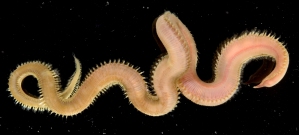Perhaps to many it may come as a surprise that the glycerid polychaete is a fascinating subject to study. What might seem like a simple worm at first glance, it comes in at about 7 inches in length with a silver sheen on the somewhat pinkish body, and flaunts a gnarly proboscis containing four black jaws used in feeding.

Fig.1 Glyceridae americana
Expecting the generic annelid characteristics with the particular worm I was looking at, I was very quickly drawn to the parapodia and branchia along the sides of the animal. The parapodia are lateral outgrowths along the worm’s body that are involved in respiration and locomotion while the branchiae are dorsal extensions of the parapodia, essentially the gills.
Fig.2 Illustration of G. americana with a close up of a parapodium and its associated branchia
The branchiae clearly had movement of cells occurring inside of them when viewed under the dissecting microscope, and I was curious to see what kind of cells were circulating and how they were being driven. I snipped off one of the branchiae from an anterior segment of the worm and prepared a slide to view it under the compound microscope. The action going on inside just the single outgrowth was really exciting; numerous, small, red disc-shaped cells, fewer large white disc-shaped cells, and several small circular green cells were circulating around in what seemed to be a patterned flow.
Fig.3 Even closer view of the branchia with the direction of cell flow of the three different cell types observed
Although the branchia was removed from the body and therefore possibly altered the movement of blood, the cells continuously flowed up one side and down the other of each individual groove or inlet of the branchia, with the smaller red cells passing around the larger white cells. The red cells seemed to move the fastest, with the smallest extracellular green cells a bit slower, and the large disc-shaped white cells barely moving by. The flow itself was not pulsating, and as polychaetes do not have a heart or cardiovascular system, ciliary movement was the force smoothly pushing the cells along the coelomic cavity. Also amazing was the fact that the movement of cells continued after the branchia was removed from the body for about 40 minutes. The video below shows the circulation of cells.
The next thing I was interested in finding out was the likely function(s) of each cell type, assuming at least one type was a part of the blood system. In their book Polychaetes, Greg Rouse and Fredrik Pleijel confirm that “Glyceridae lack a circulation system, the respiratory pigment is located in disc-shaped erythrocytes floating in the coelom” determining that one of the cells are indeed involved in respiration and that cilia are the driving force rather than muscular pulsing (112). An email from Jenna Moore, a polychaete expert, explained that the “glycerids [do] have hemoglobin…[and the] green [cells] could be chlorocruorin, another blood pigment” however the large translucent white cells still remain to be identified. The glycerids display a great visual of blood flow in the worms through their branchia and seeing all of this and how it worked under the microscope was great. Further research in this area of blood cells and the circulatory pathways involved in invertebrates would be fascinating.
Ashley Shiner
University of Washington
Literature Cited:
Pleijel, Fredrik and Greg Rouse. Polychaetes. New York: Oxford University Press, 2001. 112. Print
